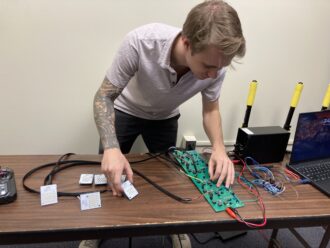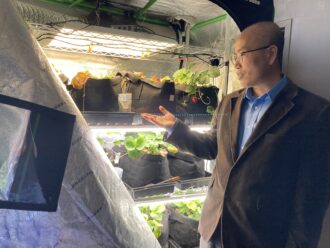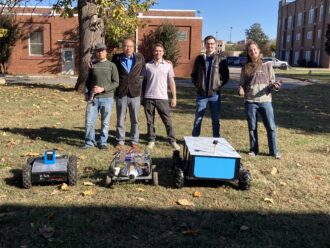MURFREESBORO, Tennessee – In the not too distant future of sustainable weed management, a farmer rolls a robot out to a crop field, and using a combination of virtual reality, precision agriculture, and artificial intelligence, zaps weeds with a laser -- leaving the cash crop to grow unimpeded in an environment free of weeds and the chemicals needed to get rid of them.
It sounds like science fiction, but Hongbo Zhang, an agricultural engineer at Middle Tennessee State University, is turning fantasy into real science.
Zhang, along with colleagues and several engineering students, are developing a robotics-based directed optical energy weed removal platform as a more sustainable method of weed management than chemical applications. They are designing systems, which can be built inexpensively with low-cost maintenance, that cater to both larger commodity crop farmers (thousands of acres) and small-acreage crop producers (30-50 acres). The work is being funded through a Southern Sustainable Agriculture Research and Education (SSARE) $20,000 On-Farm Research Grant.
“Directed energy is an important weed removal technique for integrated weed management. It can be used alone or in companion with other sustainable practices such as cover crops, and has proved to be capable of weed management based on previous research,” said Zhang. “The extensible features of a low-cost robot enable it to conveniently interface with other equipment to construct a complete precision agriculture ecosystem.”

The directed energy weed management platform consists of several parts:
- Deep learning via image processing to teach the robot to recognize the difference between weeds and the cash crop;
- Optical light sources to determine which kills weeds the best;
- The development of the robot to deliver the laser treatment to weeds in the field; and
- Virtual reality technology to allow the farmer to direct the robot to various parts of the field.
Much of the work remains confined to the engineering labs at the university at the moment, but Zhang is pleased with the progress.
“We have been working very hard on the development of the robotics platform, as well as the optical source for weed removal. Overall, we have completed the design of the robotics platform prototype and the light source prototype,” said Zhang. “We have made initial tests of both platforms and results show that the optical weed removal technique works effectively.”
Researchers are testing three kinds of light sources for optical weed removal: UVC, infrared, and white light. They’ve found that UVC wavelengths damage the plant at the cellular level, leading to plant death. In addition, infrared light can burn the weed leaf and stem.

“While the mechanisms of infrared light are different from UVC, they work together to achieve effective weed control,” said Zhang.
Lastly, students are working on a combination of imitation learning, GPS, and 3-D modeling (using thousands of images of crops and weeds) to recreate crop fields, complete with the cash crop, weeds and other field objects in a software package used by the farmer to help the robot identify which objects in the fields are weeds to target for optical weed removal.
The next steps, said Zhang, is to take the technology to the field, and train farmers on how to use the platform. Other cooperators on the project include Middle Tennessee State University research assistants Basel Mahmoud, Reece Arnold, Sean Tyler, Ibrahim Alijilani, Dhrutiben Patel, Connor Anderson, and Jake Dams; and undergraduate students Matthew Crist, Robert Jablonka, and Kevin Kongmanychanh.
View Related SARE Grants:
- Development of Novel Directed Optical Energy Weed Management Robotics Platform for Sustainable Soybean Farming (OS22-160)
- Novel Energy Efficient UVC Autonomous Robotics Platform for Sustainable Strawberry Fungal Management (GS22-271)
